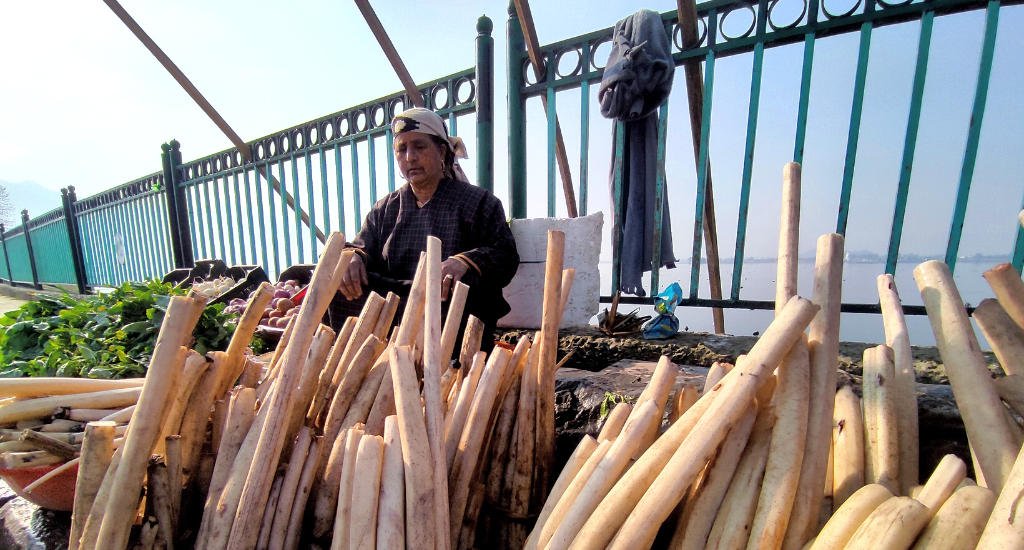
Here’s why you should add Kashmiri nadru to your menu
The lotus stem that grows in abundance in Kashmir’s lakes is a major crop for farmers and a tasty treat for millions, sometimes selling at Rs 500 a kg.

The lotus stem that grows in abundance in Kashmir’s lakes is a major crop for farmers and a tasty treat for millions, sometimes selling at Rs 500 a kg.
The sun has barely yawned out of the snowy cliffs, but men on small boats are busy stabbing the windswept water of the Dal Lake in Srinagar with long poles. What are they up to in this cold when everyone else is snug at home, sleeping in slothful stupor like the lotus-eating Lotophagi islanders that Odysseus came across in Greek mythology?
The men in woollen pherans—a warm Kashmiri cloak—aren’t up so early to catch common carp. They’re not carrying nets or angling rods. They’re not looking for watergrass, fodder for their livestock, either. The Dal has none in the winter.
Siblings Nazir Ahmad Akhoon, 48, and Showkat Ahmad Akhoon, who is two years younger, are among the boatmen scanning the lake for lotus stems hidden under the surface. They feel for the stems with their poles and pull out the long, creamy white rhizomes with a “shum”, a metal fork tied to the end of their pole.

The edible rhizome, the subterranean stem, of the lotus plant is called “nadru” in Kashmiri and “kamal kakdi” in the plains of India. It is a typical winter delicacy that defines the picturesque region’s equally delish cuisine.
Found in the shallow waters of Kashmir’s lakes, nadru is one of the most expensive vegetables in the Valley. And “Dael nadur”, or lotus stem from the Dal, is considered the best for its teasing taste and whitish colour.
In the markets, the stems are graded and bunched according to their length and girth. The top-quality rhizomes can be as expensive as Rs 500 a kg. The price varies, invariably shooting up during festivities.
The crunchy, mild-flavoured lotus stems are peeled, sliced and eaten raw or cooked. When sliced across, the ivory cylinders show a lace-like design with pea-sized holes.

According to the US Department of Agriculture (USDA), lotus stems are naturally cholesterol-free and fat-free, and contain essential micronutrients such as potassium, calcium, magnesium, B vitamins and vitamin C. Potassium and magnesium reduce blood pressure, and with a low glycaemic index of 33, it makes an ideal food for blood sugar management.
Set the science apart. Its delicate flavour is reason enough to include nadru in meals — from pickles to curries to fries. Steamed, boiled or sautéed.
It’s integral to the Kashmiri culinary culture and no feast, be it on Eid, Navroz or Shivratri, is complete without it. It has such a hallowed standing that gifts of nadru are exchanged when people meet. It’s a treat during family get-togethers.
“My son studies abroad and is returning home after a year. I am going to prepare a nadru dish for him. He loves nadru,” said Hafeeza Akhtar in Srinagar’s Lalbazar, carrying a bunch of thick and succulent lotus stems.

Nadru and fish fit together well and this combination spawns an all-loving signature dish — “nader gaade” (scroll down for the recipe).
Mix it with the leafy collard greens to make “nader haakh”, or cook it with radish to get “nader muje”. On the streets, this versatile veggie is sold as a lip-smacking snack or “chaat”.
The harvest begins when leaves of the lotus plants wilt in autumn. For six months until March, nadru farmers living near Kashmir’s lakes — especially Dal and Anchaar where the lotus grows in abundance — pick stems in tonnes, worth lakhs of rupees. Some of these are dried for use in the summer months.
From cultivation to marketing, hundreds of families across Kashmir benefit from this crop.
“I have been doing this for 20 years. My two sons and I harvest 10,000 to 12,000 bunches of lotus stems every year. This is a major source of our income,” said Ghulam Mohammad Akhoon. When demand shoots up, Akhoon hires extra hands.
The devastating floods of 2014 gave those associated with the crop a scare. Lotus plants almost died out in Dal and Anchaar, but some quick-thinking farmers rented marshy parcels in neighbouring Ganderbal, and grew the endemic lotus there with seeds that were preserved earlier.
After the floodwaters receded, the plants were brought back to their natural homes, where they soon spread and thrived.
It’s hard to find words doing justice to the Kashmiri love of nadru. Perhaps Tennyson, from his “The Lotos-Eaters”, could help: “To hear each other’s whisper’d speech; Eating the Lotos day by day.”
The lead image at the top shows nadru farmers Nazir and Sowkat harvesting lotus stems in the lake (Photo by Nasir Yousufi)
Nasir Yousufi is a journalist based at Srinagar.